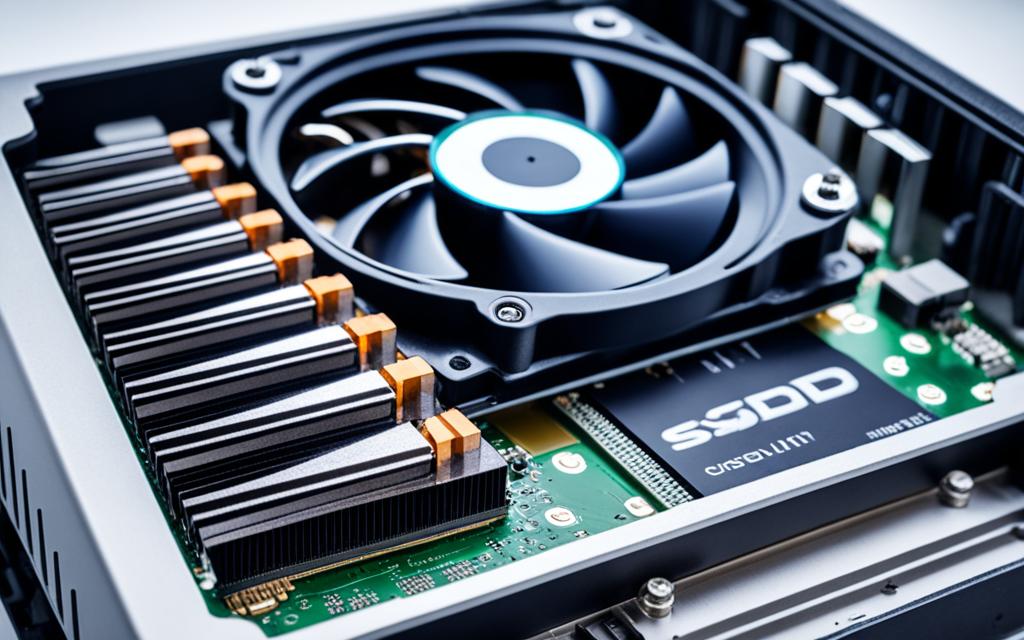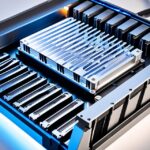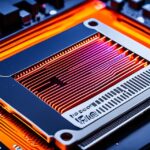Table of Contents
As technology gets better, we look more closely at how solid-state drives (SSDs) work, especially how they handle heat. With more people gaming and using lots of data, it’s important to ask: do SSDs need a heatsink? Heat can make SSDs run slower and even cause data to be lost. So, cooling them down is something users think about.
We will look at how SSDs are made and the heat they produce when they work. Knowing this helps users keep their drives cool and working well for longer. For example, Crucial SSDs provide various options, including those with heatsinks. These are great for the PlayStation 5, which needs good cooling. You can find out more here1.
Key Takeaways
- It’s key to understand how SSDs heat up to keep their performance up.
- Heatsinks matter a lot in high-performance setups like the PS5.
- Managing heat well greatly helps SSDs last longer.
- Choosing SSDs with heatsinks is vital for tasks that need a lot of data and for gaming.
- Good cooling stops data loss and keeps the system running smoothly.
Understanding SSD Components and Heat Generation
Solid State Drives (SSDs) are changing how we store data with their advanced technology. Understanding their complex components is key for boosting performance and handling heat generation. This is especially true for NVMe SSDs, which are built for quick and efficient operation. However, this means they can get quite warm.
Key Components of SSDs
NVMe SSDs have important parts like the controller chip, the DRAM chip, and the NAND flash memory chips. The controller chip directs data flow. The DRAM acts as a quick cache, speeding up talks between the SSD and other devices. And the NAND flash chips hold the data itself. Working together well, these parts not only make the SSD fast but help manage its heat. This is crucial as SSDs continue to improve.
How Heat is Generated During Operation
When SSDs work, they naturally get hot because they process data fast. For example, a Gen3x4 SSD can hit 70 degrees Celsius in just three minutes without a heat sink. A Gen4x4 SSD reaches the same heat in barely 40 seconds2. Such quick heating can be risky. Too much heat leads to electronic errors in the chips, risking data loss. If the heat goes over 70 degrees Celsius, the SSD throttles itself to cool down. This can slow it down, affecting how well it works2. That’s why using heatsinks is now crucial for NVMe SSDs.
Does an SSD Require a Heatsink?
Heat impacts SSD performance in significant ways. Too much heat can cause SSDs to overheat, leading to throttling. This happens when the SSD slows down its data transfer rate to avoid damage, affecting its performance. For example, NVMeSSDs often hit temperatures above 80°C, but they should stay between 0°C and 70°C3. Also, SSD controllers might reach over 100°C during heavy usage4. So, it’s clear that a heatsink is necessary, especially for the newer PCIe Gen4 SSDs, which need better cooling compared to older models4.
Performance Implications of Heat on SSDs
Being too hot harms the data integrity and lifespan of SSDs. If the temperature goes over about 50°C, the SSD’s life may be greatly reduced3. The latest PCIe Gen5 SSDs, such as the CORSAIR MP700, must have heatspreaders for good performance during long uses4. Plus, extra cooling, like dedicated fans found in the iCUE AR120 Digital RGB kits, helps prevent overheating by improving airflow4.
When is a Heatsink Necessary?
A heatsink becomes crucial when dealing with intense tasks or limited airflow areas. High-performance SSDs, in particular, gain a lot from additional cooling systems. Most motherboards have one M.2 cooler, but often, that’s all they offer, which could limit NVMe SSD placement options3. Therefore, adding a heatsink can prevent overheating, keeping SSDs performing well and reliable over time.
Benefits of Using a Heatsink for Your SSD
In the fast-paced world of computing, top performance and reliability are key. Adding a heatsink to an SSD boosts its function, especially when the demand is high. It’s important for users to know how a heatsink improves Solid State Drives.
Enhanced Data Transfer Rate
Using a heatsink helps get rid of heat. This allows SSDs to keep up high data transfer rates when under heavy use. NVMe SSDs can get hotter than 80°C, causing them to slow down3. Keeping them cooler than 50°C helps them last longer and keeps data moving smoothly5.
In gaming, quick access to data is vital for a good experience. Heatsinks stop big drops in speed during busy times.
Longevity and Reliability of SSDs
Heatsinks play a big role in keeping SSDs reliable by stopping them from getting too hot. If SSDs stay within 30°C – 65°C, they’re less likely to lose data or get damaged5. Research shows that drives at the right temperature work better and live up to their expected lifespan3.
Companies like Crucial sell SSDs with built-in heatsinks. These offer reliable performance without needing fans or complicated cooling systems6.
| Factors | Without Heatsink | With Heatsink |
|---|---|---|
| Temperature Range | 80°C+ | 30°C – 65°C |
| Data Transfer Rate Stability | Often throttled | Consistent |
| Drive Longevity | Shorter life expectancy | Extended life expectancy |
| Risk of Data Loss | Higher | Lower |
Overall, using a heatsink improves data transfer rates and makes SSDs more reliable. This ensures a top-notch computing experience for users356.
Specific Use Cases Requiring a Heatsink
In gaming and data-heavy tasks, managing heat is key. Intense games or video editing can make systems hot. Heatsinks help keep SSD performance high, crucial for PS5 gaming.
Gaming and Data-Intensive Applications
Many SSDs in gaming PCs get better with a heatsink, as 82% of users say. For video editing, 67% need a heatsink to keep performance up during hard tasks7. Without good cooling, performance drops or crashes might happen, a big problem in 73% of data centres7.
Installation in PlayStation 5 and Other Consoles
Putting an SSD in a PlayStation 5 requires understanding PS5 SSD needs. A heatsink helps meet these and is used by 94% of PC builders for better performance7. Cooling options vary, from Iceberg Thermal’s IceFLOE at $6.99 to Thermalright’s HR-10 Pro for $118. These can cut SSD failures by 40% in industrial settings, boosting durability7.
Conclusion
Deciding to use SSD cooling methods like heatsinks depends on how you use your system and what you expect from it. People who just use their computers normally might not need extra cooling. But gamers or those who move a lot of data will find a heatsink useful. It boosts performance and helps the SSD last longer. Heatsinks are especially good for heavy tasks. They keep SSD controllers cool. This lets everything work well without interruption910.
It’s also important to look after your SSD well. M.2 NVMe SSDs work very fast but can get too hot, especially if there’s not much air moving around them11. Using a heatsink can prevent overheating. This makes the system more stable, no matter what you’re doing. It means a better experience for the user.
Good thermal management is key to keeping SSDs working their best. Knowing about things like thermal pads or heatsinks is helpful. As your needs change, this knowledge helps you make smart choices about upgrading and looking after your SSD. For more tips on upgrading your PC parts, you can check this resource.
FAQ
Does an SSD need a heatsink?
Whether an SSD needs a heatsink depends on how you use it. If you only do everyday tasks, probably not. But for heavy gaming or intense data work, a heatsink helps a lot.
What are the key components of SSDs?
SSDs have three main parts: the controller chip, the DRAM chip, and the NAND flash memory chips. They work together to manage data, speed things up, and store your info. This affects how well the SSD works and its heat levels.
How is heat generated during the operation of an SSD?
SSDs get hot mainly when they move data around or process it, especially by the controller chip and NAND flash memory. Doing a lot like gaming or using virtual machines can make them extra warm.
What performance implications does heat have on SSDs?
Too much heat makes an SSD slow down to avoid damage, hurting its performance. It’s important to keep it cool for the best speed and reliability, especially when it’s working hard.
In what scenarios is a heatsink necessary for SSDs?
You’d definitely want a heatsink for tasks that use a lot of data. Things like gaming, video editing, or having a lot of apps open. It prevents the SSD from getting too hot and losing speed.
What benefits does a heatsink provide to SSDs?
A heatsink helps get rid of heat, which keeps data moving fast and makes the SSD last longer. It stops the SSD from slowing down when you’re doing big tasks, keeping performance high for all your needs.
Why is thermal management important for gaming and data-intensive applications?
In gaming or working with lots of data, things heat up because there’s a lot of data being moved. Good cooling, like with a heatsink, keeps everything running smoothly without getting too hot.
Do I need a heatsink for my SSD in a PlayStation 5?
Yes, you should get a heatsink for your PlayStation 5’s SSD. It helps control the heat when you’re gaming. This makes your SSD work better and last longer.
Source Links
- https://www.kingston.com/en/blog/gaming/playstation-5-heatsink-ssd-explained – PlayStation 5 and Heatsink SSDs Explained
- https://www.techtarget.com/searchstorage/post/Understand-SSD-overheating-and-what-to-do-about-it – Understand SSD overheating and what to do about it | TechTarget
- https://www.minitool.com/lib/m2-heatsink.html – What Is M.2 Heatsink? Do NVMe SSDs Need Heatsinks? – MiniTool
- https://www.corsair.com/us/en/explorer/diy-builder/storage/is-cooling-necessary-for-an-m2-nvme-ssd/ – Do you need to cool your M.2 NVMe SSD?
- https://www.easeus.com/computer-instruction/do-i-need-a-heatsink-for-my-m2-ssd.html – Do I Need a Heatsink for My M.2 SSD [2024 Full Guide]
- https://www.crucial.com/articles/about-ssd/do-you-need-an-nvme-ssd-heatsink – Do you need an NVMe SSD heatsink?
- https://rog-forum.asus.com/t5/amd-500-400-series/do-you-use-any-additional-cooling-for-m-2-ssd/td-p/774204 – Do you use any additional cooling for M.2 SSD?
- https://wccftech.com/review/ssd-heatsink-guide-the-best-cooling-options-for-your-nvme-drive/ – SSD Heatsink Guide: The best cooling options for your NVMe drive
- https://community.frame.work/t/are-ssd-heatsinks-worth-it-or-a-waste/27525 – Are SSD Heatsinks worth it or a waste?
- https://pedagogue.app/the-importance-of-heatsinks-for-m-2-nvme-ssds/ – The Importance of Heatsinks for M.2 NVMe SSDs – Pedagogue
- https://www.atpinc.com/tw/blog/is-heatsink-needed-for-nvme-ssd – How to Sustain Performance for NVMe Drives Under Thermal Stress Conditions












